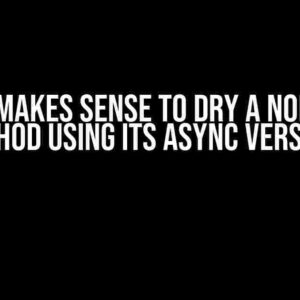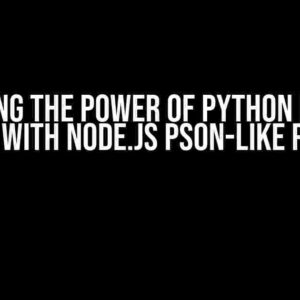In the world of object-oriented programming, inheritance is a fundamental concept that allows us to create classes that build upon each other. But what happens when we instantiate a socket in a parent class and wonder, does it belong to its child class? In this article, we’ll dive deep into the world of sockets, inheritance, and explore the answer to this burning question.
What is a Socket?
A socket is a endpoint for communication between two devices (computer, phone, etc) in a network. It’s a 4-tuple that consists of source IP, source port, destination IP, and destination port. When a socket is instantiated, it allows data to be sent and received over the network.
Sockets in Object-Oriented Programming
In object-oriented programming, a socket can be instantiated in a class, allowing the class to send and receive data over the network. But what happens when we create a child class that inherits from the parent class that instantiated the socket?
The Inheritance Conundrum
When a child class inherits from a parent class, it inherits all the properties and methods of the parent class. But does that mean the socket instantiated in the parent class belongs to the child class?
The Answer: It Depends
The answer to this question depends on the programming language and the way the socket is instantiated in the parent class. In some languages, the socket is tied to the instance of the class, while in others, it’s tied to the class itself.
Java: The Socket Belongs to the Instance
In Java, when a socket is instantiated in a parent class, it belongs to the instance of the class. This means that each instance of the child class will have its own socket, separate from the parent class.
public class ParentClass {
private Socket socket;
public ParentClass() {
socket = new Socket("localhost", 8080);
}
}
public class ChildClass extends ParentClass {
public ChildClass() {
// The socket is instantiated in the parent class,
// but it belongs to the instance of this class
System.out.println(socket.toString());
}
}
Python: The Socket Belongs to the Class
In Python, when a socket is instantiated in a parent class, it belongs to the class itself. This means that all instances of the child class will share the same socket.
class ParentClass:
socket = None
def __init__(self):
self.socket = socket.socket(socket.AF_INET, socket.SOCK_STREAM)
self.socket.connect(("localhost", 8080))
class ChildClass(ParentClass):
def __init__(self):
# The socket is instantiated in the parent class,
# and it belongs to the class itself
print(self.socket.fileno())
C#: The Socket Belongs to the Instance
In C#, when a socket is instantiated in a parent class, it belongs to the instance of the class. This means that each instance of the child class will have its own socket, separate from the parent class.
public class ParentClass {
private Socket socket;
public ParentClass() {
socket = new Socket(AddressFamily.InterNetwork, SocketType.Stream, ProtocolType.Tcp);
socket.Connect("localhost", 8080);
}
}
public class ChildClass : ParentClass {
public ChildClass() {
// The socket is instantiated in the parent class,
// but it belongs to the instance of this class
Console.WriteLine(socket.Handle.ToInt32());
}
}
Conclusion
In conclusion, whether a socket instantiated in a parent class belongs to its child class depends on the programming language and the way the socket is instantiated. In some languages, the socket belongs to the instance of the class, while in others, it belongs to the class itself.
Best Practices
When working with sockets in object-oriented programming, it’s essential to follow best practices to avoid any confusion or unexpected behavior.
- Document Your Code: Clearly document your code to indicate whether the socket belongs to the instance or the class.
- Use Access Modifiers: Use access modifiers to control access to the socket, ensuring that it’s not modified unintentionally.
- Test Your Code: Thoroughly test your code to ensure that the socket behaves as expected in both the parent and child classes.
| Language | Socket Ownership |
|---|---|
| Java | Instance |
| Python | Class |
| C# | Instance |
Frequently Asked Questions
Q: Can I instantiate a socket in a static method?
A: Yes, you can instantiate a socket in a static method, but it’s not recommended. Static methods belong to the class itself, and instantiating a socket in a static method can lead to unexpected behavior.
Q: Can I use a singleton pattern to share a socket across multiple classes?
A: Yes, you can use a singleton pattern to share a socket across multiple classes, but it’s not recommended. Singleton patterns can make your code tightly coupled and difficult to maintain.
Q: How do I close a socket in a child class?
A: To close a socket in a child class, you can call the `close()` method on the socket instance. However, make sure to check if the socket is null before calling the `close()` method to avoid a `NullPointerException`.
In conclusion, understanding socket ownership in object-oriented programming is crucial to avoid unexpected behavior and ensure that your code works as expected. By following best practices and documenting your code, you can ensure that your socket-related code is maintainable, efficient, and easy to understand.
Frequently Asked Question
Get ready to quench your thirst for knowledge about socket inheritance in parent-child classes!
Does a socket instantiated in a parent class automatically belong to its child class?
Ah-ha! Yes, a socket instantiated in a parent class is indeed accessible and belongs to its child class. When a child class inherits from a parent class, it inherits all the parent’s attributes, including the socket instance.
What happens if I override the parent class’s method that creates the socket in the child class?
Good question! If you override the parent class’s method that creates the socket in the child class, the child class will have its own socket instance, which is separate from the parent class’s socket instance. So, be careful when overriding methods that handle sockets!
Can multiple child classes share the same socket instance from the parent class?
Absolutely! Multiple child classes can share the same socket instance from the parent class, as long as they don’t override the parent class’s method that creates the socket. This is one of the benefits of inheritance – shared resources!
What if I want each child class to have its own separate socket instance?
Easy peasy! You can simply create a new socket instance in each child class, or override the parent class’s method that creates the socket in each child class. This way, each child class will have its own separate socket instance.
Are there any performance implications when sharing a socket instance across multiple child classes?
Good thinking! Yes, sharing a socket instance across multiple child classes can have performance implications, especially if multiple classes are accessing the socket concurrently. Be mindful of synchronization and consider thread-safety when sharing resources like sockets.




